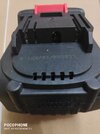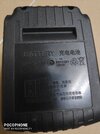Hi, I would like your help with an issue I have with my new cordless impact drill's battery. I bought it from Aliexpress about four months ago. the battery (picture attached) was loaded, so I used it 3 or 4 times and left it without use for about two months. 3 day ago, I wanted to use it but found that the battery is dead. I've tried to charge it with the charger supplied with it (picture attached). it was connected for 24 hrs, but the battery is still dead. I suspect the the charger is faulty because the green led is on as soon as it's plugged into the mains, even without the battery connected to it, as it's seen in the picture, the plug is disconnected. I thought that the led should light in red until the battery is charged, but that's not the case. the green is constantly on. one more point that brings me to believe that the problem is with the charger and not the battery, is the fact that it worked. now, after all this long story, I would like to ask for your help to find a simple as possible charger circuit - the battery is rated 20V and 3Amps. as far as I know, the charging current should be 10%, so 300mA. I'm not considering to address the seller about the issue because it will be an endless saga.






